Scenarios from Cervid Operations
These scenarios represent real situations that could occur, but were created for educational use and are not based on any specific cervid operation.
Scenario 1. Deer purchase at Katie’s Breeding Operation
After careful consideration, we started a small breeding operation on our farm in southeastern Minnesota back in 2010. This was not something we considered lightly due to the immense amount of work needed to start a deer operation. I discussed this with a few other deer producers and thought it would be something my family and I would enjoy. After getting the proper approval from the Minnesota Board of Animal Health, I built my double-fenced breeding pen that could be divided up inside by a single fence if needed, in total about 4.5 acres. Being in SE MN, farmland surrounds our pens entirely, with only a few trees. We rarely saw wild deer or other animals on our farm, our dogs helped keep other wild animals away. Our goal was to breed does and bucks to sell to other breeding farms and hunting preserves in other states.
Everything was going well, and after five years of owning deer, we were certified and allowed to sell deer to other states. We rarely purchased deer from other locations, but after eight years we wanted to try and diversify our genetics. We purchased two does from one herd and three bucks from a different herd. Soon after, we received the dreaded notification: the farm that we purchased the does from was placed under quarantine due to a positive CWD result. We euthanized the three does we purchased from the quarantined farm and our veterinarian sent in samples for testing. Results from one doe came back positive for CWD. Unfortunately, there was nothing we could do about it. After we collected indemnity, we had to depopulate our whole herd and keep our fenced area fenced from wild cervids for five years. We have one year left of quarantine until we are able to take down the fences.

Ways to protect from direct contact with farmed cervids
This will be challenging for many who rely on importing cervids from other operations. Importing deer who appear normal but are infected is a major risk for all operations. To better protect your herd, consider not importing live cervids to your operation. Using artificial insemination to breed your does with semen collected from other cervids may help reduce the risk. As a caution, studies are underway to evaluate if semen can transmit infectious prions, so this recommendation may change in the future.
If you need to import cervids, consider importing from a low-risk herd, one that has been closed to introductions from other herds for several years and tests 100% of all dead cervids for CWD. You may want to ask for verification of their farm records and test results, and their farm biosecurity program - to know that they have not shared any equipment (feeders, water troughs, chutes, buckets, antler removal equipment, bolus guns, multiple-dose syringes, etc) between herds. Also consider that operation’s risk of CWD from other pathways of infection, including from wild cervids.
Other ways Katie was Protecting herself from CWD:
Katie was taking other steps to help protect her herd from CWD. She started with double-fencing to minimize interactions with wild cervids and other animals. Having minimal trees next to the fence helps in numerous ways. It creates another barrier/clearing to prevent animals from crossing the fence, minimizes the risk of storms knocking trees onto fences, and reduces perching areas for avian predators. Katie was also following State and Federal regulations for her herd in regards to testing, inventory, and movements.
Scenario 2: Fence down after lightning storm at Roger’s Hunting Preserve
I started my hunting preserve in south central Pennsylvania 30 years ago. As an outdoor enthusiast, I wanted to start a business that I knew I would enjoy. I have a 500 acre elk hunting preserve with cabins on site to allow for an exciting hunting experience.
Four years ago, we had a really bad storm. The next morning when I made my fence inspection rounds, I saw significant damage -- the storm had knocked down some trees right onto the fence on the west side of the hunting preserve. The fence was completely open. I immediately started fixing it.
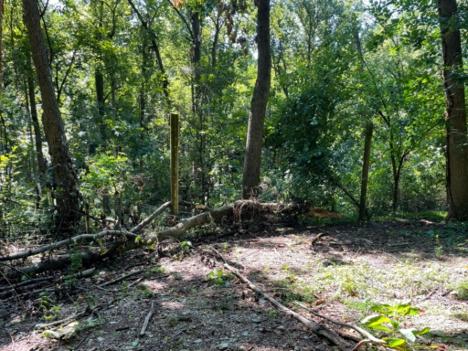
Once the fence was repaired, I tried my best to do a herd inventory. It was hard to account for all of the deer, given that they were out roaming in the preserve.
A month later, during my annual inventory inspection, I discovered two wild white tailed deer inside my e hunting preserve. They must have gotten in during that storm that knocked down my fence. After notifying the State Game Commission, we shot the deer right away. Due to the CWD requirements in PA, we submitted the deer head and lymph node tissues to the lab for testing, and one of the results came back positive for chronic wasting disease. That deer looked fit and healthy, I couldn’t believe it.
Because of that positive wild deer inside my pens, I was placed in quarantine, but still allowed to operate my hunting preserve. Rules in place restricted any carcass or deer from leaving my property. Throughout the next two years, I tested all of the hunted elk and never had another positive. Three years after the wild deer got into my preserve, however, four hunted elk came back positive for CWD. Only elk in the preserve tested positive, seven other elk in the breeding pen that died naturally throughout the years were not positive for CWD. The only thing I can think of is that those wild deer must have brought it into my herd.
Why is a broken fence such a problem?
Direct contact between a CWD-infected wild cervid and susceptible farmed cervids can occur through a fencing breach if a wild deer enters your property or if escaped farmed cervids are allowed re-entry into your herd after interacting with wild cervids. In addition, the potential for CWD infection through nose-to-nose contact between infected wild deer and farmed cervids exists if single fencing is used.
Biosecurity Mitigation Practices:
- Monitor and maintain perimeter fences. Repair holes and washouts as soon as possible to prevent wildlife from entering your property and to prevent escape of your animals.
- Consider installing exclusionary fencing (options include double fencing, a strand of electric fence along perimeter fences, or mesh/solid plastic fencing) to discourage contact between farmed and wild cervids.
- Reduce or eliminate forage and forested areas immediately outside the perimeter fence to help make the fence less attractive to both wild and farmed cervids.
Scenario 3: Forest critters in Jack’s White Tail Deer Preserve
For the past 13 years, my family has raised white-tailed deer in northern Wisconsin. This started as a family hobby, but the business has grown over the years and we now raise trophy bucks to stock our hunting preserve. The hunting preserve has a creek that flows through it, as well as forested areas that provide an ideal hunting opportunity. Hunters from all over the US come to hunt on our preserve.
Our facility has three pens: one pen is for my favorite deer -- these deer are more like pets and I would never sell or hunt them, the second pen is the breeding pen, and the third is the larger hunting preserve. The hunting preserve is wooded (photo), which creates a great hunting experience for hunters.
In total, the pens are about 200 acres, single-fenced to a height of 10 feet. I thought about double-fencing the entire area, but that was too expensive. I planned to someday double-fence the breeding and pet pens.
We now have a total of 76 deer and are in the Not enrolled CWD program since we stock our hunting preserve with our own deer. I don’t see the need to become an enrolled herd since I don’t sell my deer to other operations. Because I am not enrolled in the CWD Herd Status Program, as a hunting preserve, I am required to test 50% of the hunted deer.
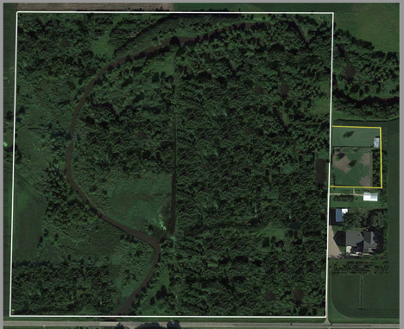
Five years ago, after I learned that CWD was found in wild deer in my county, I made some changes on the farm. I began sourcing my hay from an area in Minnesota with no CWD-positives to date, closed my herd to new introductions, and decided I would double-fence the two smaller deer pens.
One morning I noticed a doe acting strange. She was a smaller doe that had previously looked a little on the skinny side, but I figured she was just a small deer. That morning, however, her head was hanging low with drool coming from her mouth. Instantly, I began to worry. I called my veterinarian who recommended I cull her and test for CWD. A month after my veterinarian sent in the samples, the state veterinarian called me to tell me the doe was positive for CWD.
My family was devastated -- all our hard work over the years gone. We were placed under quarantine and allowed to continue our hunting preserve, at least for a short time. We just could not add more deer to it. We eventually depopulated the whole herd and collected indemnity. It was hard, my family loved some of these deer like pets and were heartbroken over the whole ordeal.
The State department of agriculture conducted an epidemiological evaluation on our operation but could not determine exactly how CWD entered the herd. They did note that there were numerous signs of wild animals in and around the deer pens. This wasn’t surprising to me. I have never seen wild deer along the outside of the fenceline, but know they are there from seeing their feces and evidence of nearby scrapes during the rutting season. On my rounds feeding the deer, I often see tracks and feces of raccoons and other wild animals around and in the open feeder, which is placed near the fence for my ease of feeding. One night, I even saw a raccoon climbing the fence near the feeder. We sometimes see coyotes around as well, especially near our compost pile where we dispose of carcasses of our resident deer. They are certainly not deterred by our farm cats.

Why may wild (and domestic) scavengers be important?
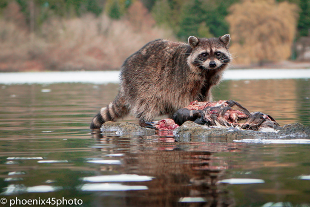
Infective prion protein from tissues of CWD-infected animals survives for long periods in most environmental conditions and may be the source of CWD infection to susceptible cervids. If CWD has been found in wild deer in the area, infective material may be in the surrounding environment from infected deer urine, feces, and decomposing carcasses. Scavengers and wildlife can spread CWD through their feces or their body. Studies have shown that coyotes and crows can spread CWD in their feces while raccoons can spread it through their decomposing carcasses. After scavenging carcasses of dead animals, wild mammals and birds may carry infective material through the perimeter fence into cervid pens, which may pose a risk to cervids inside the fence. Domestic scavengers such as cats may similarly play a role.
Wild animals (and cats) seem ubiquitous, so can anything be done? The potential for indirect contacts through other animals from infected wild deer to farmed cervids may be reduced by making sure to use farm practices that do not attract these wildlife to your operation. Although it is impossible to fully prevent wildlife from entering, there are steps to take to reduce the number of wildlife entering.
CWD Biosecurity Mitigation Strategies:
- Reduce use of practices that could attract wild animals through the perimeter fence to the farm.
- Place feeders and waterers away from perimeter fences to minimize direct contact with wild cervids and indirect contact with wild animals. Feeders or waterers placed near the outer perimeter fence line can act as an attractant for wild animals (raccoons and others) which can climb over and through fences or through trees to get to the feed or water. Feeders can also attract wild cervids to the fence, especially if it is an open feeder that allows for grain to spill onto the ground.
- Remove and dispose of cervid carcasses in a manner that does not allow access by wildlife or attract them to your cervid pens.
- Store feed and hay so it is not accessible to wild cervids or animals.
- Remember that other animals on the farm, including cats, could also bring infectious material through the fence line to potentially infect cervids.
Scenario 4: Traveling truck on Matt’s Hobby Farm
My wife raised deer on her family farm growing up and convinced me to add a few white-tailed deer on our small hobby farm in northwest Minnesota. We only had a little over 2 acres available for the deer pen and did not want too many animals; we decided to buy three does and a buck. That was seven years ago; currently we have five does. The buck was spooked a few months ago and broke his neck on the fence while running away. Being a smaller area, we cleared a perimeter around the fence to keep predators away. I don’t need bears and wolves trying to get our deer. I am able to grow my own hay and get concentrate feed from the Co-op in town. Overall the deer have been a nice addition to our farm.
I like to hunt for bigger trophy animals. I recently traveled with some friends to a hunting location in Wyoming and Colorado to try our luck. I drove my personal truck, the only truck we have, for the entire trip.
The weather during the trip was horrible. In fact, it rained each day. It was so muddy, I was covered in mud, my friends were covered in mud, and my truck was covered in mud. There was dirt everywhere -- on our clothes and boots, in every crevice of the truck, the undercarriage, and the wheel wells.
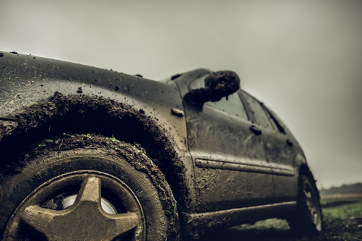
When we returned from the hunting trip, we took precautions against spreading CWD, since I realized that it was known to be present there. We made sure to follow the deer carcass movement regulations. We only brought boned out meat back with us and caped a large elk ourselves so we could have it mounted in MN. We did not bring back any brain or spinal cord tissue and We washed all the blood off our boots and hunting gear as best we could.

I was mindful that I used the truck for jobs on the farm, so decided to run it through a car wash before arriving home. With inflation and gas prices going up and up these days, I picked the cheap $6 basic wash. It seemed to do the job, though I did notice some mud still in a few places. I cleaned off the rest of the mud from the undercarriage later in the week outside of the hunting preserve on my farm.
Even after all of the precautions I have taken, might I have accidentally exposed my farm to CWD through my hunting?
How can hunting in another area be a problem with respect to bringing CWD to my farm?
In this case we are looking at indirect transmission of CWD through contact with infected material through hunting or taxidermy practices. If the infected material comes in contact with your cervids, it could result in transmission of CWD.
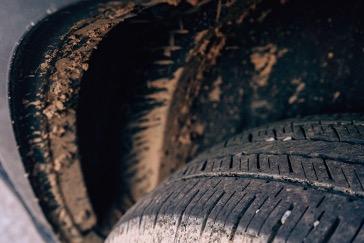
If hunting in an area where CWD is in the wild cervid population (and the environment), infected dirt, plants, and other organic material from the environment can be tracked from the hunting area to the operation site via vehicles, boots, clothing, or other hunting equipment. If boots or tools are used for hunting purposes, they should be thoroughly cleaned and disinfected.
More information on cleaning and disinfection can be found in the following references:
2018 AFWA Technical Report on Best Management Practices for Prevention, Surveillance, and Management of Chronic Wasting Disease (page 76).
After reviewing these scenarios, are you interested in evaluating the potential risks of CWD transmission to your operation?
If you want to move forward, download the CWD Risk Assessment by clicking here.